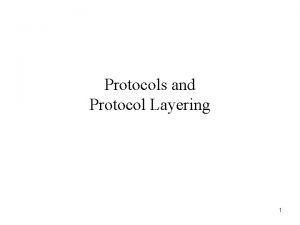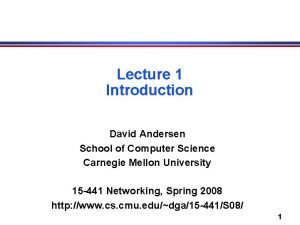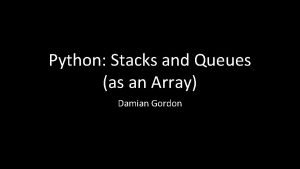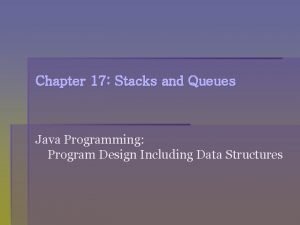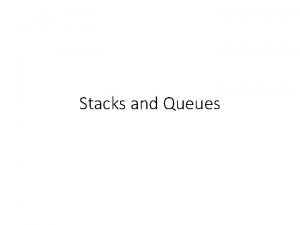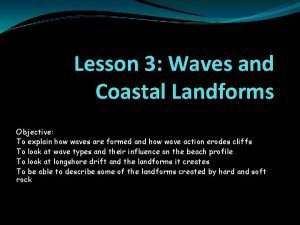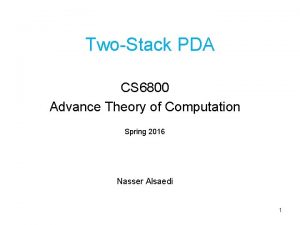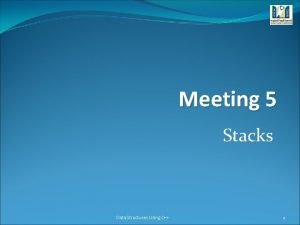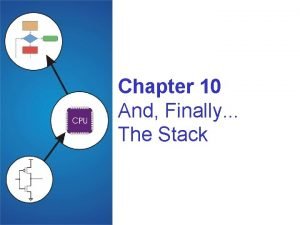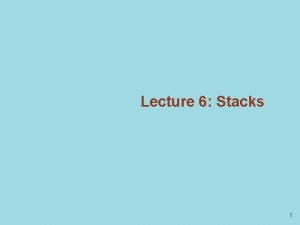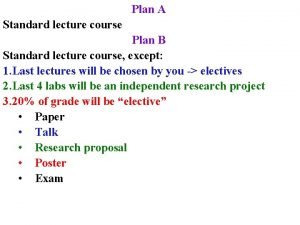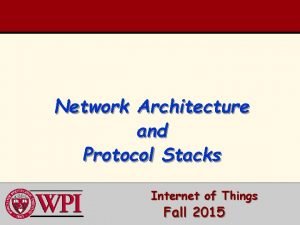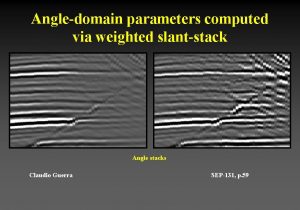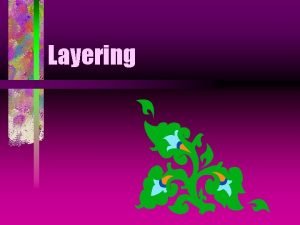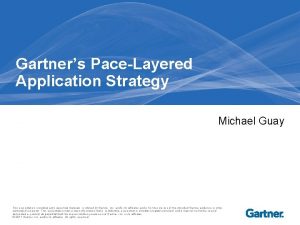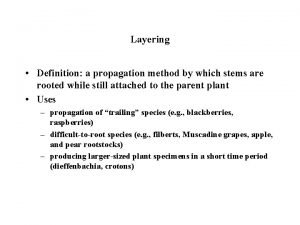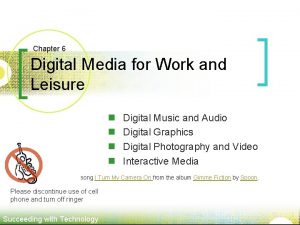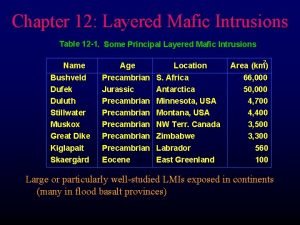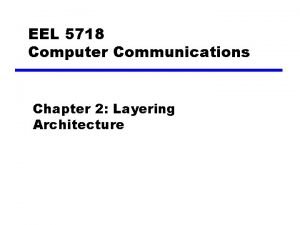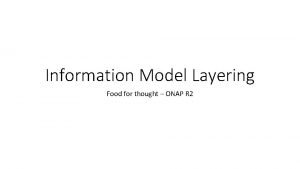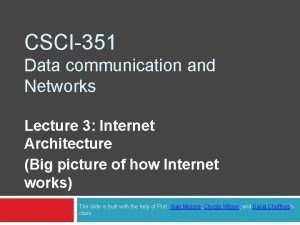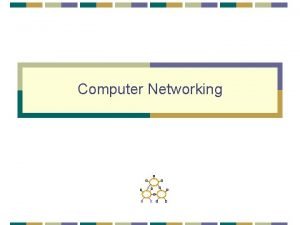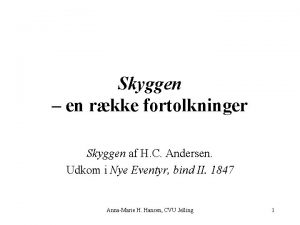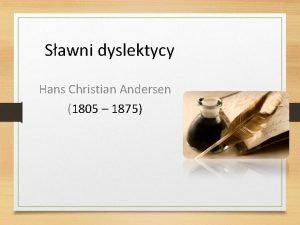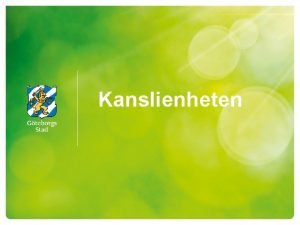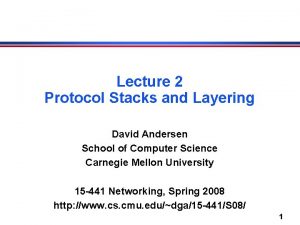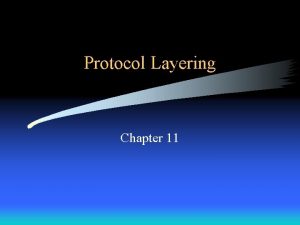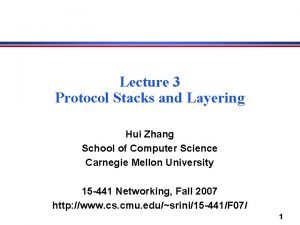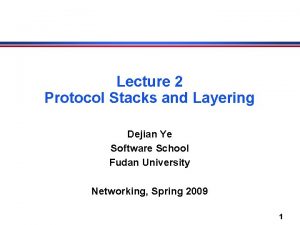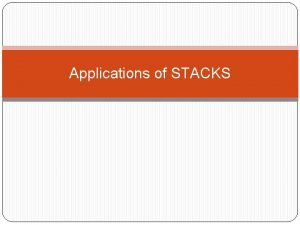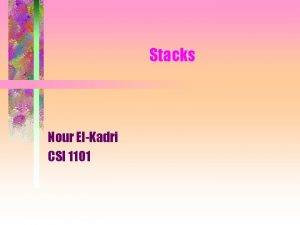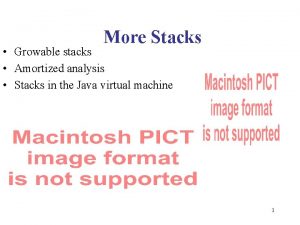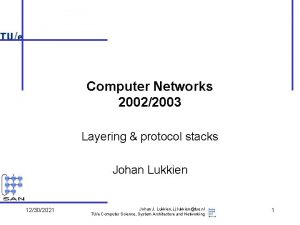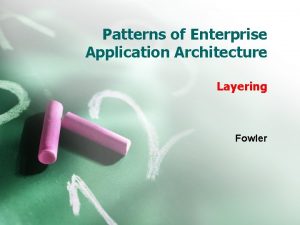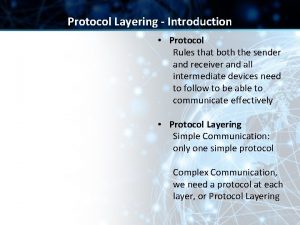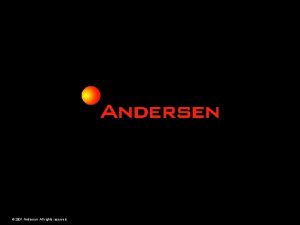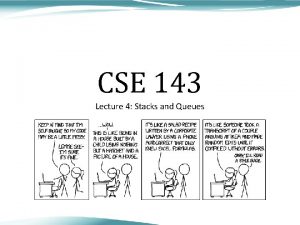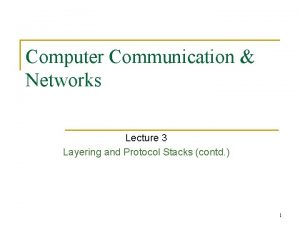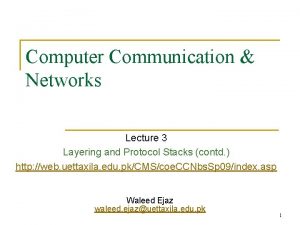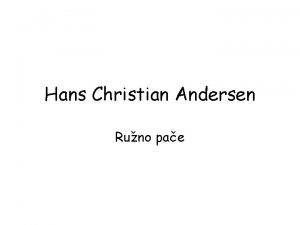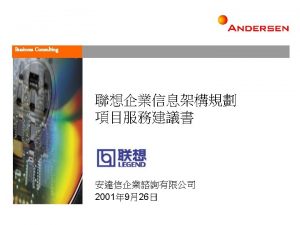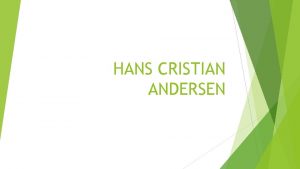Lecture 2 Protocol Stacks and Layering David Andersen






































- Slides: 38

Lecture 2 Protocol Stacks and Layering David Andersen School of Computer Science Carnegie Mellon University 15 -441, Computer Networks 1

Last Time l The Big Picture » Goals: – Efficiency – “ilities” (scalability, manageability, availability), – Ease of creating applications » Challenges: – Scale – Geography – Heterogeneity (** today’s focus!) l A few specific details: » Circuits vs. packets » Little bit about routing » Service model and how to construct services (** today!) 2

Today’s Lecture l l Last time: “Big picture” Today: » General architectural principles for networks » Introduces a few concrete models & examples l Where we are going: » Tuesday: Socket programming review++ (for project) » Thursday: Application examples (still high level) » After that: Burrowing into the details, ground up l Today’s specifics: » » » What is a protocol. Protocol stacks. Some history. Standards organizations. Application layer. 3

Why protocols and layering? l l l Interoperability Reuse Hiding underlying details 4

What is a Protocol Friendly greeting l l l An agreement between parties on how communication should take place. Protocols may have to define many aspects of the communication. Syntax: » Data encoding, language, etc. l Semantics: » Error handling, termination, ordering of requests, etc. l l l Protocols at hardware, software, all levels! Example: Buying airline ticket by typing. Syntax: English, ascii, lines delimited by “n” Muttered reply Destination? Pittsburgh Thank you 5

Interfaces l Each protocol offers an interface to its users, and expects one from the layers on which it builds » Syntax and semantics strike again – Data formats – Interface characteristics, e. g. IP service model l Protocols build upon each other » Add value – E. g. , a reliable protocol running on top of IP » Reuse – E. g. , OS provides TCP, so apps don’t have to rewrite 6

Protocol and Service Levels Application End-to-end Core Network 7

A Layered Network Model The Open Systems Interconnection (OSI) Model. 7 Application 6 Presentation 5 Session 4 Transport 3 Network 2 Data link 1 Physical 8

OSI Motivation l Standard way of breaking up a system in a set of components, but the components are organized as a set of layers. » Only horizontal and vertical communication » Components/layers can be implemented and modified in isolation l l Each layer offers a service to the higher layer, using the services of the lower layer. “Peer” layers on different systems communicate via a protocol. » higher level protocols (e. g. TCP/IP, Appletalk) can run on multiple lower layers » multiple higher level protocols can share a single physical network l “It’s only a model!” - TCP/IP has been crazy successful, and it’s not based on a rigid OSI model. But the OSI model has been very successful at shaping thought. 9

OSI Functions l l l l (1) Physical: transmission of a bit stream. (2) Data link: flow control, framing, error detection. (3) Network: switching and routing. (4) Transport: reliable end to end delivery. (5) Session: managing logical connections. (6) Presentation: data transformations. (7) Application: specific uses, e. g. mail, file transfer, telnet, network management. Multiplexing takes place in multiple layers 10

Looking at protocols l Hop by hop / link protocols » Ethernet l End-to-end protocols » TCP, apps, etc. l Management / “control plane” protocols » Routing, etc. – Can be either link or e 2 e themselves – Definition somewhat vague. l Standards » File formats, etc. l E. g. , JPEG, MP 3, … Categories not solid / religious, just a way to view things. 11

Heterogenous Sources of Components l Application: web server/browser, mail, distributed game, . . l Presentation/session. » Often part of application » Sometimes a library l Transport/network. Application Presentation Session » Typically part of the operating system l Datalink. » Often written by vendor of the network interface hardware l Physical. » Hardware: card and link Transport Network Data link Physical 12

Motivation: Many many Network Components Application Operating System Router Software (many protocols) Operating System Links Computer Protocol Software Router Hardware Network Interface Computer Bridge HW/SW 13

Protocols for Interoperability l l l l Many implementations of many technologies: Hosts running Free. BSD, Linux, Windows, Mac. OS, … People using Mozilla, Explorer, Opera, … Routers made by cisco, juniper, … Hardware made by IBM, Dell, Apple, … And it changes all the time. Phew! But they can all talk together because they use the same protocol(s) » Application level protocols: HTTP, SMTP, POP, IMAP, etc. » Hardware protocols (ethernet, etc) 14

Protocols for Abstraction & Reuse l Multiple choices of protocol at many layers » Physical: copper, fiber, air, carrier pigeon » Link: ethernet, token ring, SONET, FDDI » Transport: TCP, UDP, SCTP l But we don’t want to have to write “a web (HTTP) browser for TCP networks running IP over Ethernet on Copper” and another for the fiber version… » Reuse! Abstraction! » Protocols provide a standard interface to write to » Layers hide the details of the protocols below 15

Multiplexing and Demultiplexing l There may be multiple implementations of each layer. TCP IP IP » How does the receiver know what version of a layer to use? l Each header includes a demultiplexing field that is used to identify the next layer. » Filled in by the sender » Used by the receiver l Multiplexing ooccurs at multiple layers. E. g. , IP, TCP, … V/HL TOS ID TTL Length Flags/Offset Prot. H. Checksum Source IP address Destination IP address Options. . 16

Example: Sending a Web Page Http hdr Web page Application Presentation . . . Session Transport TCP header Application payload Network Data link Physical 17

Limitations of the Layered Model l Some layers are not always cleanly separated. » Inter-layer dependencies in implementations for performance reasons » Some dependencies in the standards (header checksums) l Higher layers not always well defined. » Session, presentation, application layers l Lower layers have “sublayers”. » Usually very well defined (e. g. , SONET protocol) l Interfaces are not always well standardized. » It would be hard to mix and match layers from independent implementations, e. g. , windows network apps on unix (w/out compatability library) » Many cross-layer assumptions, e. g. buffer management 18

The TCP/IP Model Application Presentation Application (plus libraries) Session Transport Network TCP/UDP IP/ICMP Data link Physical 19

Local Area Network Protocols IEEE 802 standards “refine” the OSI data link layer. Application Presentation Session Upper Layer Protocols Transport Network LLC Data link MAC Physical link service access points 20

A TCP / IP / 802. 3 Packet Application Ethernet preamble Presentation MAC header Session LLC / SNAP header Transport IP header Network Data link TCP header Physical Homework explores tradeoffs in header sizes, etc. , with different applications Data 21

Internetworking Options 7 6 5 4 3 2 1 physical 1 7 6 5 4 3 2 1 repeater 7 6 5 4 3 2 1 network 3 2 2 1 1 router data link 2 1 1 7 6 5 4 3 2 1 bridge (e. g. 802 MAC) 7 6 5 4 3 2 1 . . . 3 2 1 7 6 5 4 3 2 1 gateway 22

The Internet Protocol Suite Applications Presentation Session Transport Network Waist UDP TCP Data link Data Link Physical The waist facilitates Interoperability. The Hourglass Model 23

Some History: The Early Days l Early packet switching networks (61 -72). » Definition of packet switching » Early DARPA net: up to tens of nodes – single network – discovery of “interesting” applications l Internetworking (72 -80). » Multiple networks with inter-networking: networks are independent, but need some rules for interoperability » Key concepts: best effort service, “stateless” routers, decentralized control (very different from telephones!) » Basis for Internet: TCP, IP, congestion control, DNS, … » Rapid growth: 10 to 100000 hosts in 10 years – Driven by NSF net, research communigy 24

Recent History: Commercialization l Industry interest in networking encourages first commercial network deployment. » In part also encouraged by NSFNET policies l Introduction of the Web makes networks more accessible. » » Killer application Good user interface that is accessible to anybody Network access on every desktop and in every home Shockingly recent - 1989, caught on in ‘ 92 or so 25

Standardization l l Key to network interoperability. A priori standards. » Standards are defined first by a standards committee » Risk of defining standards that are untested or unnecessary » Standard may be available before there is serious use of the technology l De facto standards. » Standards is based on an existing systems » Gives the company that developed the base system a big advantage » Often results in competing “standards” before the official standard is established 26

Relevant Standardization Bodies l ITU-TS - Telecommunications Sector of the International Telecommunications Union. » government representatives (PTTs/State Department) » responsible for international “recommendations” l T 1 - telecom committee reporting to American National Standards Institute. » T 1/ANSI formulate US positions » interpret/adapt ITU standards for US use, represents US in ISO l IEEE - Institute of Electrical and Electronics Engineers. » responsible for many physical layer and datalink layer standards l ISO - International Standards Organization. » covers a broad area 27

The Internet Engineering Task Force l The Internet society. » Oversees the operations of the Internet l Internet Engineering Task Force. » decides what technology will be used in the Internet » based on working groups that focus on specific issues » encourages wide participation l Request for Comments. » document that provides information or defines standard » requests feedback from the community » can be “promoted” to standard under certain conditions – consensus in the committee – interoperating implementations » Project 1 will look at the Internet Relay Chat (IRC) RFC 28

Higher Level Standards l Many session/application level operations are relevant to networks. » encoding: MPEG, encryption, . . . » services: electronic mail, newsgroups, HTTP, . . . » electronic commerce, . . l Standards are as important as for “lowerlevel” networks: interoperability. » defined by some of the same bodies as the low-level standards, e. g. IETF 29

Designing applications l Application architecture » Client-server? (vs p 2 p vs all in one) » Application requirements l Application level communication » TCP vs. UDP » Addressing l Application examples (Lecture 4). » ftp, http » End-to-end argument discussion 30

Applications and Application-Layer Protocols l Application: communicating, distributed processes » Running in network hosts in “user space” » Exchange messages to implement app » e. g. , email, file transfer, the Web l Application-layer application transport network data link physical protocols » One “piece” of an app » Define messages exchanged by apps and actions taken » Use services provided by lower layer protocols application transport network data link physical l Sockets API refresher next week (remember from 213) 31

Client-Server Paradigm Typical network app has two pieces: client and server Client: l l l Initiates contact with server (“speaks first”) Typically requests service from server, For Web, client is implemented in browser; for e-mail, in mail reader application transport network data link physical request Server: l l l Provides requested service to client e. g. , Web server sends requested Web page, mail server delivers email (We’ll cover p 2 p at semester end) reply application transport network data link physical 32

What Transport Service Does an Application Need? Data loss l Some applications (e. g. , audio) can tolerate some loss l Other applications (e. g. , file transfer, telnet) require 100% reliable data transfer Timing l Some applications (e. g. , Internet telephony, interactive games) require low delay to be “effective” Bandwidth l l Some applications (e. g. , multimedia) require a minimum amount of bandwidth to be “effective” Other applications (“elastic apps”) will make use of whatever bandwidth they get 33

User Datagram Protocol(UDP): An Analogy UDP l l l Postal Mail Single socket to receive messages No guarantee of delivery Not necessarily in-order delivery Datagram – independent packets Must address each packet l l l Single mailbox to receive letters Unreliable Not necessarily in-order delivery Letters sent independently Must address each reply Example UDP applications Multimedia, voice over IP 34

Transmission Control Protocol (TCP): An Analogy Telephone Call TCP l Reliable – guarantee delivery l l Byte stream – in-order delivery l l Connection-oriented – single socket per connection l l Setup connection followed by data transfer l Guaranteed delivery In-order delivery Connection-oriented Setup connection followed by conversation Example TCP applications Web, Email, Telnet 35

Transport Service Requirements of Common Applications Application Data loss file transfer e-mail web documents real-time audio/ video stored audio/video interactive games financial apps no loss-tolerant loss-tolerant no loss Bandwidth Time Sensitive elastic audio: 5 Kb-1 Mb video: 10 Kb-5 Mb same as above few Kbps elastic no no no yes, 100’s msec yes, few secs yes, 100’s msec yes and no l. Interactions between layers are important. » persistent HTTP » encryption and compression » MPEG frame types. Loss & real-time video. 36

Server and Client exchange messages over the network through a common Socket API Clients Server TCP/UDP ports Socket API TCP/UDP IP IP Ethernet Adapter user space kernel space hardware 37

Readings l Read two papers on the motivations for the Internet architecture: » “End-to-end arguments in system design”, Saltzer, Reed, and Clark, ACM Transactions on Computer Systems, November 1984. » “The design philosophy of the DARPA Internet Protocols”, Dave Clark, SIGCOMM 88. l In-class discussion: » Briefly next Thursday » Revisit the topic in the second half of the semester 38
 Protocol agreement template
Protocol agreement template David andersen cmu
David andersen cmu Stacks and queues in python
Stacks and queues in python Java stacks and queues
Java stacks and queues Exercises on stacks and queues
Exercises on stacks and queues Java stacks and queues
Java stacks and queues Wave cut platform diagram
Wave cut platform diagram Two stack pda examples
Two stack pda examples Marine terrace geology
Marine terrace geology Types of stacks
Types of stacks Stacks in data structures
Stacks in data structures Stacks+routined
Stacks+routined 6 stacks
6 stacks Speed stacks spreads nationally in 1998.
Speed stacks spreads nationally in 1998. The individual flattened stacks of membrane
The individual flattened stacks of membrane Stacks internet
Stacks internet Angle stacks
Angle stacks 01:640:244 lecture notes - lecture 15: plat, idah, farad
01:640:244 lecture notes - lecture 15: plat, idah, farad Objectives of plant propagation
Objectives of plant propagation Tip layering plants examples
Tip layering plants examples Layering asexual reproduction
Layering asexual reproduction Pace layer
Pace layer What are the stages in money laundering
What are the stages in money laundering Examples of propagation
Examples of propagation Trench layering
Trench layering Stool layering definition
Stool layering definition This refers to the layering of different digital media
This refers to the layering of different digital media Risitic layering
Risitic layering Strict layering
Strict layering Layering food
Layering food Layering
Layering Layering
Layering Stages of money laundering
Stages of money laundering Lemon andersen please don't take my air jordans lyrics
Lemon andersen please don't take my air jordans lyrics Skyggen af h.c. andersen
Skyggen af h.c. andersen Sławni dyslektycy prezentacja
Sławni dyslektycy prezentacja Sonja andersen
Sonja andersen Hans kristijan andersen biografija
Hans kristijan andersen biografija Tepotten
Tepotten
